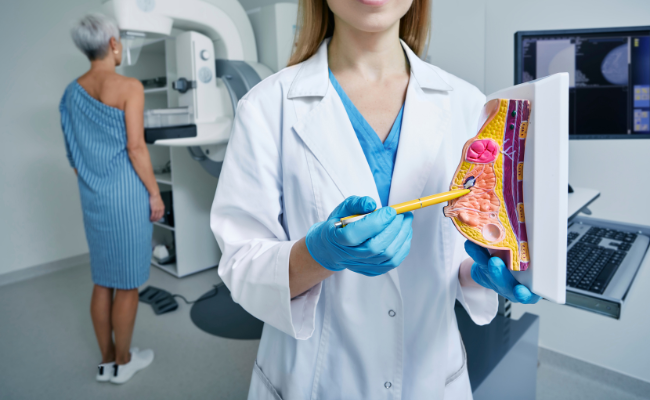How to Treat Mammographic Mass In Breast?
- December 12, 2023
- No Comments

What is a mammogram?
A mammogram is a low-dose X-ray specifically designed to examine breast tissue for early signs of breast cancer, particularly in asymptomatic individuals during routine screenings or for diagnostic purposes when symptoms arise. These symptoms may include a lump, pain, nipple discharge, or changes in breast skin. Breast cancer, excluding skin cancer, ranks as the most common cancer among individuals assigned female at birth, constituting 14% of all new cancer diagnoses in the United States. Although advancements in breast cancer treatment have contributed to improved outcomes, early detection through screening mammograms significantly enhances survival rates.
It's crucial to note that the majority of findings from mammograms are benign, with fewer than 1 in 10 individuals requiring further tests after a mammogram being diagnosed with cancer. On the other hand, the term "mammographic mass" refers to an abnormal density or lump detected during a mammogram. These masses can be either benign or malignant, and their characterization involves assessing factors such as appearance, shape, and margins on the mammogram. The identification of a mammographic mass raises concerns about its potential association with breast cancer, emphasizing the need for a comprehensive evaluation and prompt intervention.
Why is it a Concern?
The identification of a mammographic mass triggers a diagnostic process aimed at determining its nature and initiating appropriate treatment. While not all masses are cancerous, the urgency in evaluating and addressing them promptly stems from the need to rule out malignancy and, if present, devise an effective treatment plan.
How is a Mammographic Mass Diagnosed?
The diagnosis of a mammographic mass involves a systematic approach. Initially, a mammogram serves as the primary tool for detecting abnormalities. Following this, additional imaging techniques, such as ultrasound or magnetic resonance imaging (MRI), may be employed to further characterize the mass. In cases where ambiguity remains, a biopsy is recommended to obtain tissue samples for a definitive diagnosis.
Treatment Solutions for Mammographic Mass:
Biopsy and Pathological Evaluation:
- Biopsy, a cornerstone in the diagnostic process, involves the removal of a small tissue sample from the suspicious mass. This sample is then examined under a microscope to determine whether the mass is benign or malignant.
- Pathological evaluation is integral in providing crucial information about the type of cells present, facilitating an accurate diagnosis and guiding treatment planning.
- Various biopsy techniques, including core needle biopsy, fine-needle aspiration, or surgical biopsy, are employed based on the specific characteristics of the mass.
Surgical Intervention:
- Surgical removal of the mass remains a primary treatment modality. Depending on the size and location of the mass, a surgeon may opt for a lumpectomy (partial removal of the breast) or mastectomy (complete removal of the breast).
- Surgical intervention is especially crucial in cases where the mass is identified as malignant, aiming to prevent the spread of cancer to surrounding tissues.
- The choice of surgical procedure is individualized, considering factors such as the size and location of the mass, as well as the overall health of the patient.
Radiation Therapy:
- High-dose radiation is employed to target and destroy cancer cells, making it a valuable post-surgery treatment to eliminate any remaining cancer cells and reduce the risk of recurrence.
- The specific type of radiation therapy, whether external beam radiation or internal radiation (brachytherapy), is determined by the characteristics of the mass.
Chemotherapy:
- Chemotherapy involves the administration of drugs designed to kill or inhibit the growth of cancer cells. This systemic approach is effective against cancer that may have spread beyond the breast.
- The administration of chemotherapy may vary, with drugs being given orally or through intravenous infusion. The specific regimen is determined by the type and stage of breast cancer.
Hormone Therapy:
- Targeted therapy interferes with hormones that promote the growth of certain types of breast cancer, particularly effective in hormone receptor-positive cases.
- Medications such as tamoxifen or aromatase inhibitors are prescribed to block the effects of estrogen on cancer cells.
Benefits of Timely and Comprehensive Treatment:
- Early Detection and Intervention: Early detection allows for the prompt initiation of treatment, significantly improving the chances of successful outcomes.
- Preservation of Breast Tissue: Advancements in surgical techniques often enable the removal of the mass while preserving a significant portion of the breast tissue.
- Reduced Risk of Recurrence: Comprehensive treatment, incorporating surgery, radiation, and systemic therapies, contributes to a reduced risk of cancer recurrence.
- Improved Quality of Life: Advances in targeted therapies and cancer care contribute to an improved quality of life during and after treatment.
- Individualized Treatment Plans: Tailoring treatment plans based on the specific characteristics of the mammographic mass ensures personalized care, optimizing the therapeutic approach for each patient.
Comments (0)